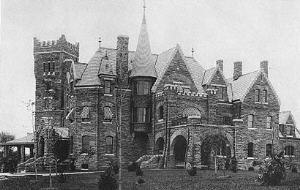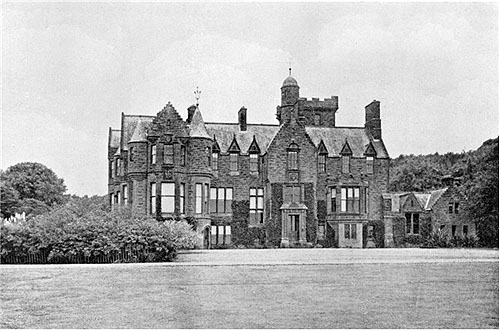

Houston was the largest landowner in Philadelphia in the 1880's, becoming wealthy from The Pennsylvania Railroad, gold mining, shipping, and petroleum products. Houston also developed the neighborhood of over 80 homes known as Wissahickon Heights that surrounds "Druim Moir". Local Chestnut Hill gray stone was used for the walls, Eastern granite for the trim, and slate for the roof. The interior is notable for the variety of woods utilized: oak for the hall and stairway, butternut for the parlor, mahogany for the reception room, quartered oak in the dining room and library, sycamore for the office, and cypress for the servant's section. Oak, cherry, and sycamore were used on the second floor, and pine was used on the third floor.
Druim Moir castle was on the market recently, offered along with 20 acres of land. The asking price was not disclosed in the advertisement.
Photo and information courtesy of Phil Bilzor.
Later, I received E-Mail that said:
I find it prudent to give you an update on Druim Moir. Much has changed since it was built. I paid a visit to Druim Moir yesterday, and as I am an architect, was invited in to see the interiors as well.
The first change, noticable to anyone at first site of the property was made by Houston's son. Houston's son removed the entire upper floors, including towers to get away from the castle look and to make it closer to an English manor, which he had become fascinated with during his trip to the British Isles. The effect is quite disconcerting.
Then, Houston's son, proceeded to go to a flat roof system (a very bad idea), which the current owners rue every time it rains or snows. All the interiors of the third floor are gone as a result, and over time the second floor interiors have all been painted over, yes, including the cherry.
The Houstons, in order to keep the place were forced to sell off alot of the surrounding land, and currently, the encroachment of other properties is unsettling. The once impressive drive now also serves to access a school and a upper scale condominium development. The condominium development is so close that I at first mistook the nearest building as a carriage house.
Another startling revelation is that it has been subdivided into three units in the worst possible way. The logical subdivision would have been into two units, the manor house as one, and the servants wing as the other. But instead, part of the servants wing is one cramped unit, for which the owners pay a ridiculous recompense, no doubt, the middle unit is a sad "shot-gun marriage" of a few rooms of the manor house and the remains of the servant's wing, and the prime property is the bulk of the manor house, which has lost two of the most important rooms to the mutant middle house, the study (by far the most impressive room), and the kitchen. As a result, the greenhouse was converted into a beautiful kitchen, which leaks constantly, and the most impressive room is wasted in the much confused architecture of the middle residence.
Druim Moir, in its original design, is the most impressive castle-manor house hybrid I have ever seen in the United States. However, the current condition of the once proud castle, is now a geriatric shell, doddering along, making sense only to itself, a sad ending for such a creature.
Druim Moir fans will find much more meaning and interest in the books and pictures of the original than they will with the current state of the property.
On 11-5-12, I received e-,mail that said:
My name is Phil Heslop and I live in Stranraer, Wigtownshire, Scotland. I am currently researching 'Castle Clanyard', a 16th Century Tower House, of which, little remains.
The stone from Castle Clanyard is reported to have been used to build an extension to 'Logan House', a few miles away. This was designed in the Scots Baronial style. However, this was later demolished and the stone from this is reported to have been transported to the USA. This is how I stumbled upon your site....and most interesting it is too! I didn't expect to find many castles in the USA.
One castle in particular, did catch my eye...'Druim Moir', Philadelphia. The reason it did so, is because Castle Clanyard and Logan House, are both situated only a few miles from the village of 'DRUMMORE'. This name has the same Gaelic meaning as Druim Moir...'Great Ridge'.

I have attached an old image of Logan House, which bears a striking resemblance to Druim Moir. Druim Moir is reported to have looked like Humewood Castle in Ireland. Logan House has a much closer resemblance.
Is it possible that H H Houston visited Logan House? Did he perhaps have some connection with our part of Scotland, Wigtownshire? And finally, do you know where the stone from Castle Clanyard is?
Back to "Castles of the United States"